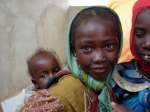IKEA campaign raises €7.7 million to brighten the lives of refugees
News Stories, 23 April 2014
LONDON, United Kingdom, April 23 (UNHCR) – IKEA customers and staff around the world have helped raise Є7.7 million to provide funding and energy for hundreds of thousands of refugees under a two-month campaign launched in February.
Under the "Brighter Lives for Refugees" campaign, the IKEA Foundation pledged to donate Є1 to the UN refugee agency for every LEDARE (light-emitting diode) bulb purchased in IKEA stores globally between February 3 and March 29.
The Є7.7 million raised will enable UNHCR to bring sustainable lighting and energy to more than 350,000 refugees in camps in Bangladesh, Chad, Ethiopia and Jordan by providing solar-powered street lights, indoor solar-powered lanterns and other renewable energy technologies such as fuel efficient cooking stoves. The campaign will also fund improved primary education.
UN High Commissioner for Refugees António Guterres welcomed the success of the IKEA initiative, which will become an annual event. "The lack of access to lighting and energy has a serious impact on the safety, security and education of millions of refugees worldwide, especially women and children," he said, before thanking IKEA customers and employees "for making such a meaningful contribution."
Today, there are nearly 10.5 million refugees globally, around half of whom are children. Some refugees have no choice but to live in refugee camps, where the absence or lack of light after sunset can affect safety and security.
Simple activities such as visiting the lavatory, collecting water or returning to a family shelter can become difficult and dangerous – particularly for women and girls.
The improvements funded by the campaign will help make each refugee camp a safer home for refugee children and their families. For example, just one solar-powered street lamp can benefit up to 300 refugees, making it safer to walk around after dark, and one solar-powered lantern can help a family of five eat after nightfall or help the children complete their homework after dark.
The IKEA Foundation has been in a partnership with UNHCR since 2010, helping to provide shelter, care and education to families and children within refugee camps and surrounding communities.


















































